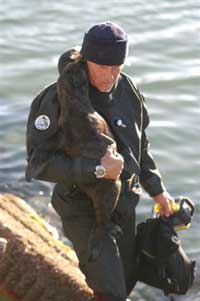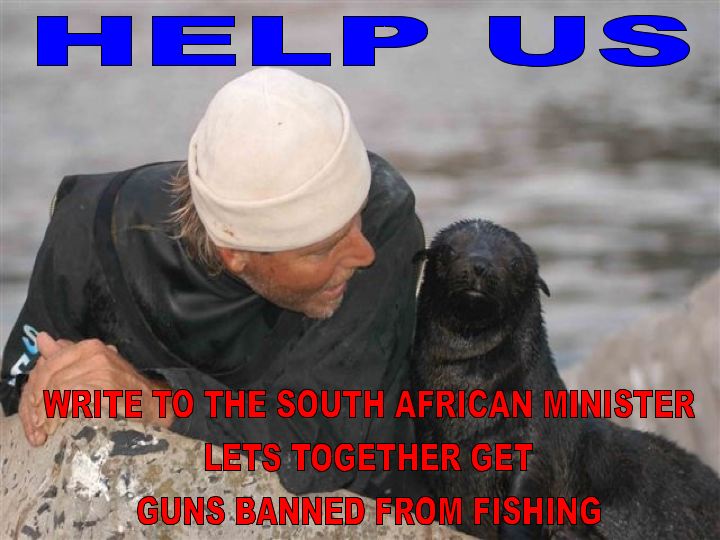THE IMPORTANCE OF SEALS ON ROBBEN - THE RETURN OF SEALS TO ROBBEN (SEAL) ISLAND - WILDLIFE - GENOCIDE ALERT - CAPE FUR SEALS - CALL FOR ENQUIRY
THE IMPORTANCE OF SEALS ON ROBBEN - THE RETURN OF SEALS TO ROBBEN (SEAL) ISLAND
SealAlert-SA sasealion@wam.co.za
Saturday, April 29, 2006 5:31 AM
Dear All Cape Fur Seal Partners,
For Seals - Robben Island is their "Berlin Wall", separating Seabirds and Seals along the entire southern African continent.
Here are some of my suggestions. In this historic meeting on the 21th, I found a group of guys willing and able to do the right thing. I believe that all that is really needed is "some very positive and constructive personal letters to each of these individuals" - each in a key position, to move them into acting for the benefit of all, and especially the seals.
I would write to:
Head of SABC 3 programming Eddie Mazingana manzinganae@sabc.co.za requesting him specifically to instruction IUCN to re-join the Seal Whisperer film and in particular the re-introduction of seals to Robben, as it would be of immense interest to millions of SA viewers as per their contract.
Head of ANC Public Relations and Chairman of Robben Island Management, Ahmed Kathrada akathrada@anc.org.za or his personal assistant shannon shanonc@robben-island. org.za . He started the world's most successful campaign to "free Mandela" and is in the ANC executive, probably the most powerful man in this whole affair. Let him know that tourists from the East specifically by-pass Robben for its lack of seals, who go instead to Hout Bay's offshore seal colony. The East actually did a travel program on Francois and his seals, to attract more tourists to SA.
Shaun Davis, the Conservation Manager of Robben Island, shaund@robben-island.org.za or his media officer Titus Chuene titusc@robben-island.org.za telling them both how important both historical and cultural it would be to see seals breeding in a colony on Robben once again. How tourists would marvel at a close-up viewing of the unique interactions which occur within a seal colony, (The only seal colony in SA where this would be possible - all others from a distance and boat-based) and how fitting it would be to have seals return to an island named after them, after a two hundred year absence.
The department which manages the seals, the department of Marine and Coastal Management, the person responsible here is scientist Dr Hermann Oosthuizen, oosthuiz@deat.gov.za and Carol Moses cmoses@deat.gov.za who is in charge of media. A letter to the Minister Martinus van Schalkwyk can be sent to his secretary, mwillemse@deat.gov.za . Pointing out in the new seal draft, that seals should be allowed to return to Robben, since banning them from islands has now ended. Commend them for making this decision.
IUCN themselves, Michael Raimondo of IUCN-Film unit michael.raimondo@iucn.org urging him to return to the Seal Whisperer film and to highlight as its main feature the return of seals to Robben, and not instead to focus on "thugs" or "criminals". CC a copy to IUCN head quarters and ex-SA Minister Valli Moosa achim.steiner@iucn.org ; president@iucn.org ; nrockman@pgwc.gov.za ; dnel@wwf.org.za .
The Public Protectors Office which has been pivotal in getting seals protected this far, could play a major behind the scenes role, write to the head Advocate Lawrence Mushwana and his two advocate investigators that got it this far, LawrenceM@pprotect.pwv.gov.za ; garyp@pprotect.org ; stoffelf@pprotect.org .
Nelson Mandela Foundation is also a good person to contact, asking for Mandela to support this "Return of Seals to Robben", verne@nelsonmandela.org
I will await a response from IUCN. Thereafter I will write to all who attended the meeting, and ask if we could all put our differences aside for the sake of the seals, tourism and SA's history and culture, and all work together to "make this happen", the return of seals to Robben.
Whilst each individual letter might take some time, I know they will be read and noted, many of you that wrote letters regarding the "planned culling of seals at Lambert's Bay" were published in the newspapers, so your letters do in fact work. These few minutes taken to write, could not only save thousands of seal life's in the decades to come, but in fact save the entire species.
This is all now in your hands, whether this fails or succeeds. You have the power, not I.
Please make this happen, lets show that something positive can still be done for the seals in the world, giving all a beacon of hope, elsewhere.
For the Seals
Francois Hugo Seal Alert-SA
PS - Please feel free to send it to the press here is a contact website for all
http://www.groundwork.org.za/Resources/media_contacts.asp
Monday, April 24, 2006 7:31 AM
SealAlert-SA sasealion@wam.co.za
Dear Cape Fur Seal Supporters,
I have written this report in order so that all can not only understand the past, but see how vital it is that Seals begin colonising the largest island in southern Africa, named after them.
Please make every effort to support this, for if not properly supported, it makes all rescue and anti-sealing initiatives pointless.
To those that already have, thank you !
Francois.
----- Original Message -----
From: SealAlert-SA
To: Titus Chuene
Sent: Monday, April 24, 2006 6:33 AM
Subject: The importance of seals on Robben
The Return of Seals to Robben (Seal) Island
Why is the return of seals to Robben Island of such vital importance? According to MCM seals have grown from near extinction in 1900 to an estimated 1.5 - 2 million by 1997, and are therefore of no conservation concern. Whereas seabirds whose numbers were unknown in 1900, and which is believed numbered, for example the African penguin, at over a million have declined, and are therefore endangered or of a conservation concern. Accordingly, as population official figures go back only 30 years, both MCM and Seabird conservationists have adopted a policy of managing these species in the "here and now" trends. I propose and believe this approach is fundamentally flawed, because it gives a distorted view of wildlife trends and therefore their conservation needs, as there has been unprecedented human interference upon both these species for centuries. With over 100 species of seabird and just 1 specie of seal competing for the same resources and breeding habitat, this official policy is doomed to fail from the start. The yardstick being used is not historical balance of a biodiversity environment on their endemic breeding habitat, but simply of that of a declining trend in any one of the 101 species found off our southern Africa coast. With this approach, we will continually be saving the declining minority whilst ignoring the whole or the majority, who in turn will become the minority. In a sense, an Apartheid system on animals.
Over 2 million ha are envisaged by wildlife managers for the protection of terrestrial wildlife for southern Africa. In the case of marine wildlife there is only 1000 ha of island land or 0.05%. Breeding habitats are therefore crucial to marine wildlife. We need to therefore consider this in all our policy making.
Cultural and Heritage
From a cultural and heritage perspective. According to the earliest historical accounts of the Portuguese, Dutch, French and English, breeding herds of seals dominated the offshore islands. As clearly seals should as it is what the natural world intended. Naturally seals and seabirds co-existed in harmony, as well. Particular historical references to this can be found in the following;
*
* In 1601, Sir James Lancaster wrote, Robben Island (Saldanha) - in this island there is great abundance of seals and penguins, in such number as is almost incredible.
*
*
* In 1604, Sir Henry Middleton wrote, Robben Island - where we found such infinite number of seals that it was admirable to behold. All the seashore lies overspread with them, and up towards the middle of the island there be infinite number of fowls called penguins, pelicans and cormorants.
*
*
* In 1601, Joris van Spillbergen wrote, Dassen Island - but with a quantity of sea-wolves (seals), besides this we also found a quantity of Dassie, furthermore, there is also a great abundance of birds as that sort called penguins.
*
*
* In 1605, Sir Edward Michelbourne wrote, Dassen Island - upon said island is abundance of great Conies and seals.
*
*
* In 1607, David Middleton wrote, Penguin Island (Saldanha) - went to penguin island, where we saw such abundance of seals and penguins, that it was admirable, but in mine opinion, there is not an island in the world more frequented with fowls and seals then this island.
Professor Andy Smith of the Archaeological department at UCT and Dr Woodbourne of CSIR in his Seal Ecology paper, both confirm, prior to human interference, disturbance and exploitation, seals only bred on offshore islands prior to 1940. A number of these islands were in fact named after these large colonies of seals by the earliest explorers. In 1576, Perestrello named the bay today known as Algoa Bay, Baia des Lobos, "bay of seals"
because of the large number of seals found there. Robben Island and Robben Island in Saldanha described by Sir James Lancaster in 1601, is just a few examples of these references to large colonies of seals on offshore islands.
According to once head of Marine Mammals, Specialist scientist Dr Jeremy David of MCM, now retired, over 23 island seal colonies are extinct. According to the Seabirds and Seal Protection Act of 1973, it lists 33 islands and rocks for the conservation and protection of these species, and there is no listing at all for any mainland colonies. Under Cites both species enjoy equal protection under appendix 2 listing. According to MCM's own official Seal pup population surveys, every island larger than 2ha, is extinct to breeding seals, and have remained so for the past 30 years of protection, growth and conservation, islands like Bird and Seal Island Algoa Bay (Bay of Seals), Dyer Island (20ha), Robben Island (576ha), Dassen (273ha), Vondeling (21ha) and the islands of Saldanha - Malgas, Marcus, Meeuwen, Schaapen and Jutten (66ha) and the northern most island Penguin island (2.2ha). In fact every island off the coast of South Africa.
In total there is 985 ha of protected island land in South Africa, according to MCM Seal breeding only occurs on 10ha or just over 1%. On this total of 10 ha, there are 10 seal breeding colonies, meaning on average less than 1 ha per colony. In complete opposite, each of the 11 seabird islands is on average for the past 30 years, 88 ha or 88 times bigger. Clearly with seabirds breeding on 99% of the protected offshore land, it is fair to say seabirds have displaced the more dominant seals, not only unnaturally aided by humans, but to the extent with which it has already caused the extinction of every island seal colony in South Africa, and poses a very real threat to the future conservation of seals and collapse of the whole marine eco-system.
From our eastern most seal colony, (Bay of Seals - Algoa Bay) a Dr Stewardson has reported seals have been restricted to the smallest awash rock in the group of many islands in this bay, known as Black Rock, where with an existing Seal named island already extinct, she has further reported in the last 12 years, seals have further declined by 82%. This is confirmed by MCM own official population surveys, which recorded 1702 pups in 1971 and in 1997, only 142 pups were born. Without further records, there is a very real chance that over the last decade, this colony might be on the brink of extinction. Likewise Robben Island, the biggest island in southern Africa has been extinct to breeding seals for over 200 years, as has the second largest Dassen. At our northern most seal colony, Penguin Island, MCM have a proposal before the Minister to cull hundreds of seals, even though this island has officially been recorded by MCM as remaining extinct from 1971 through to 1997, when unofficially seals have been breeding there since 1985.
As far back as 1638, Artus Gijsels wrote, went with longboat to Robben Island, he reported, that there was nothing there but one penguin, and no wild beasts except a few seals, all of which must have been exterminated. In 1880, the famous ship the HMS Challenger brought naturalist Moseley to South Africa and he wrote, I paid a visit to an island in False Bay, called Seal Island. The whole place is a rookery of the Jackass Penguins. In 1893, the then government of the day acknowledged the fact that the Cape Fur Seal was on the verge of extinction as a species and introduced protection under the Cape Fish act.
From 1900, this near extermination of the Cape Fur Seals from islands once dominated by them, would naturally have left an ecological "hole" in the breeding habitat upon these islands, which would unnaturally have been filled with an increased seabird population,aided by both increased habitat and increased available prey resources. This unfortunately is where modern seabird conservation begins and hence its flaw. Citing seabirds are now endangered today because of what they were 100 or even 50 years ago is unnatural, due to the unnatural near extinction of breeding seals on islands.
Instead of MCM scientists seeking to rectify this. They aided and unnaturally enforced this further, building walls around most of the larger islands, employed "herdsmen", light-house personnel, CapeNature conservation staff and even full-time foreigners, to shoot seals attempting to haul-out, and in general maintained "seal shooing" programs that banned seals, that are still in force today, on every island. As a result, as reflected clearly in MCM's official seal population surveys, for the past three decades, seals have sort refuge and have been restricted to the smallest awash rocks in South Africa. A classic example of this is Seal Rock in False Bay, in 1880 a penguin colony, by 1997, although only a rock of 2 ha, has become the largest offshore seal breeding colony in southern Africa. Difficulties in landing and harvesting seals on such small rocks, the seal population recovered, and as density quickly became a problem. Forced upon this species by 1940, the unnatural migration north and onto the mainland, began.
Officially MCM still projects a healthy seal population of 1.5 - 2 million, with a total pup production of 313 281 recorded in 1997. Well aware that since the late 1980's, 80% of all pups were now being born on the mainland unnaturally, MCM ignored this. As too, the first mainland mass mortality in 1988, the direct cause starvation, involving 250 000, or the one in 1994 or the 300 000 in 2000, in fact Namibian officials state 2006, pup breeding season to be the worst yet. Between 1990 and 2000, Namibian authorities report their 80% of the seal population has dropped by 55%. There is no sound natural reason for this mass northern migration of the seal population, for similarly in the same period, the Namibian pelagic and deep-water fish stocks have declined to almost zero. With Namibian fishing fleets now by agreement fishing in SA waters to prevent complete closure.
In South Africa the situation is equally as bleak. MCM has again claimed that the seals are growing at 3%. However compared to other Fur Seals species, growths of 14% are more common, in fact, with a maximum mortality of 32% for pups and a 10% for old adults, the Cape Fur Seals should be averaging around 14% per year. Penguins for example have averaged a growth of 10%. Even at 3%, after 3 decades, there should be a doubling in the number of pups born in SA. Instead we see almost zero growth on these small awash seal rock colonies, 35 531 pups recorded in 1971 and 36 772 in 1997. Quite clearly we can expect no more growth coming from our offshore seal population in SA, the result of this density and aided by the low lying of these less than 3 metre high rocks, confronting ocean swells of 5 - 10 metres, especially during pupping time, when pups cant swim or are waterproofed, ensures that we will endure increasing incidents of mass washing ashore of pups, who are experiencing up to a 90% failure rate.
In 1990 the Cape Fur Seals, endemic to the Cape, become officially known as the South African Fur Seals, in order to address these unnatural imbalances forced upon these seals, and is in further danger with less than 10% living on offshore rocks in South Africa, of becoming officially known as the Namibian Fur Seal or perhaps, as per recent further northward migration trends away from sealing/culling mainland's, the Angolan Fur Seals. Perhaps this is the intention all along.
Robben (Seal) Island, extinct for over 200 years to seals can address all these unnatural human induced interferences, that have disrupted this ecological balance for centuries. At 250-times larger than the largest offshore seal colony, it offers significant possibility. So large in fact, if every seal in southern Africa, including the 80% in Namibia on the mainland, had to re-migrate back to this single island Robben, they would only occupy less than 6% of this island land.
In apparent conflict with some endangered seabird conservation, seals on Robben could offer solutions of reduced critical habitat conflict or even from predation on seabirds at other sensitive seabird sites, as is currently allegedly occurring at numerous seabird breeding colonies, both on our east and west coasts. Naturally, seals are designed and as such need the islands for as much as 50% of each day, to pup, to bred, to rest, to heal, to raise their young and to moult, with their pups needing the islands for 10 to 12 months continuously.
Restricted unnaturally to these small awash rock colonies, density and overcrowding, especially during pupping time, becomes major issues leading to a 90% pup failure and causing cows to pup unnecessarily on the coastline and abort their young. Up to 40 000 deaths and their rescue, could to a certain extent be reduced, by offering the seals an alternative haul-out site to alleviate these problems.
Seal Eco-tourism already in existence for over 25 years, where even the smallest seal colony, so small its colony has never been counted as it is considered a non-breeding colony, has seen increased Tour Boat Operator entrants who have invested millions in tour-boats to ferry tourists to the seal colonies. This smallest seal colony, generates over R20 million in direct ticket sales, much of it in foreign exchange, where over 400 000 tourists delight in paying for the right to view our seal wildlife. Making it one of the top ten attractions in the Cape. In the process, hundreds of jobs are created and with many in the previously disadvantaged or unemployed sector now earning significant sustainable income.
Like Mandela took the Long Walk to Freedom from Robben Island for his people. Robben has the same ability to do so for it's endemic and indigenous Cape Fur Seal population, a species found nowhere else on earth. Its uniqueness is evident in many aspects;
*
* Tourism - This would be the only Seal-Viewing colony where tourists can view seals for the first time, in their true and natural habitat, an offshore island proper. It would also be the only colony open to the public, where the unique interactions between seals can be viewed at close range. The birth and raising of pups. The establishment of harems. The mating of bulls and cows. The moulting and the amazing interactions that occur throughout the year. Previously not possible when viewed from a considerable distance from a tour boat.
*
* Cultural - Many foreign countries visitors, especially those from the East seldom visit Robben during their stay, when asked about the reasons for this, claimed there is little or no wildlife upon the island, and as such prefer due to time constraints within their tight tour schedules, to visit the Seal Colony off Hout Bay instead. In the process robbing South Africa of the opportunity to educate others of our unique culture and history, both in human and animal terms, that Robben has to offer.
*
* Scientific - It would be the only colony in South Africa where seals can be studied and observed living in their "pristine and wild" state as nature intended upon sizeable offshore islands. Many as yet, unanswered questions about correct natural mortality rates of new-borns, the migration to and from the colony, the role of alpha bulls and the size of harems, the natural growth of the population, the mortality rate, the entanglement factor and percentage. Many, many questions can be answered, that under current conditions offer no possible "natural" answers. Including seabird interactions, and where there is in fact any positive interactions between seals and seabirds, to help guide future policies and address certain conflict areas.
In general, the re-establishment of a fully functioning, breeding Cape Fur Seal colony on Robben Island is the most significant development towards conservation this species will have seen in centuries. In re-turning seals to Robben (Seal) Island, the largest island in southern Africa, is akin to the apartheid government unbanning the ANC and freeing Mandela, which lead to the New and better South Africa.
Please allow this to become the new and better South Africa, for the Cape Fur Seals as well.
For the Seals
Francois Hugo Seal Alert-SA
021-790 8774
SealAlert-SA sasealion@wam.co.za
Monday, April 3, 2006 11:24 PM
DEAR ALL SUPPORTERS,
I ask all who read this to please W R I T E to the officials listed.
It does work and the seals need our collective VOICE - PLEASE !
Francois Hugo Seal Alert-SA
----- Original Message -----
From: SealAlert-SA sasealion@wam.co.za
To: mwillemse@deat.gov.za ; clenders@deat.gov.za ; stoffelf@pprotect.org ; garyp@pprotect.org ; LawrenceM@pprotect.pwv.gov.za ; verne@nelsonmandela.org ; akathrada@anc.org.za ; jbell@ifaw.org ; dnel@wwf.org.za ; nrockman@pgwc.gov.za ; president@iucn.org ; achim.steiner@iucn.org
Sent: Tuesday, April 04, 2006 12:19 AM
Subject: Wildlife Genocide Alert - Cape Fur Seals - Call for Enquiry
IN
SOUTH AFRICA
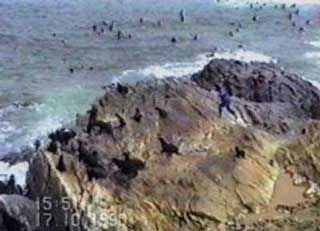
Genocide is an International Crime Against Humanity, but as you will see, it has been applied to Nature, right here in South Africa by our Conservation Officials, as well.
According to the President of Genocide Watch, Gregory Stanton, genocide develops in 8 stages. The FBI has found similar stages for Hate Groups. Stage 1 - Classification, "them and us". Stage 5 - Polarization, Hate Groups broadcast polarizing propaganda. Stage 6 - Identification. This is now a Genocide Alert . Victims are identified and separated out. Stage 7 - Extermination, and Stage 8 - Denial.
The Citizen Newspaper, Friday 24th March 2006, "Slaughter of gannets by murderous seals" and the Argus Newspaper, "It's the sub-adult males (seals) with time on their hands". Article by awarding winning Environmental Writer, John Yeld. SABC 50/50, a wildlife television program on the 30th June 2002, "They (seals) are cruel bastards" and "It's murder on the high seas"
So, when does conservation end and genocide begin? For some years now I have been researching the reasons why, even though the Cape Fur Seals have been a protected species, since 1973. Whole island seal colonies continue to remain extinct, yet remain protected wildlife sanctuaries, seal pupping occurring on unnatural locations in foreign countries and seal cows appearing to create mass suicide for their new-born. These conservation "Seal Hate Groups" have waged a WAR for decades and we are well past Stage 8.
I therefore call upon, all who reads this, to urgently request the Minister of Environmental Affairs and Tourism, Mr Martinus Van Schalkwyk to urgently set-up a "Commission of Enquiry", in order for this decades old "policy" of Animal Wildlife Genocide on protected Cape Fur Seals in South Africa, can be fully investigated.
Please CC your request to the following:
Minister, mwillemse@deat.gov.za; Head of Ministry, Advocate Helen Venter, clenders@deat.gov.za; Head Public Protector Investigations, stoffelf@pprotect.org ; garyp@pprotect.org ; Public Protector, LawrenceM@pprotect.pwv.gov.za ; Nelson Mandela, verne@nelsonmandela.org ; Chairman of Robben Island and ANC Exective, akathrada@anc.org.za ; Jason Bell, jbell@ifaw.org; Dr Deon Nel, dnel@wwf.org.za; Natasha Rockman, nrockman@pgwc.gov.za
Under the constitution of South Africa, both Seals and Seabirds are defined as an economic resource. Under the Sea Birds and Seals Protection Act no 46 of 1973. Both species enjoy equal protection under CITES appendix 2. Under schedule 1 of the Act, 46 offshore islands and rocks are listed as protected areas. Historically both species shared these offshore breeding habitats, with seals the dominant specie on the larger islands. In the new Seals and Sea Birds draft policy released in March 2004, no mention is made of correcting past "economic harvesting imbalances", now that commercial sealing, seabird egg harvesting and guano removal has ended in the late 1980's.
Marine conservationists from the department of DEAT, MCM, Avian Demography Unit and CapeNature, would have you believe that although both species require the same habitat and prey on the same "food resources", seabirds are more threatened than seals. In fact, during various seabird workshops, scientists list seals as seabird's no.1 threat and humans 5th.
The 46 offshore islands and rocks, equate to 1025 ha of protected land. 2000 years ago, the sea-level was at least 3 metres higher. This would have placed, all current offshore seal colonies under water. Every island larger than 2ha and higher than 3 metres is today currently extinct to seals, and has remained so for the past 30 years of official protection. Today seabirds are found on 990 ha and seals 10ha, divide amongst 18 offshore colonies or just 1%.
Geographically, although the islands stretch from Algoa Bay on our east coast to Namibia on our west coast.
86% of these lies in a narrow band of 250km known as the Cape West Coast.
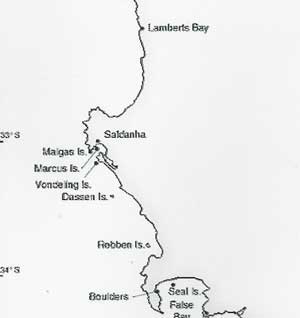
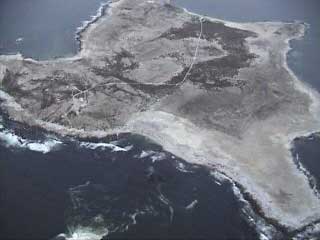
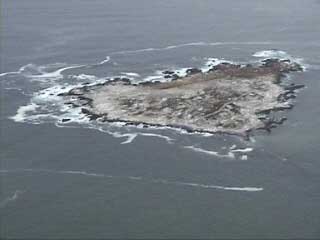
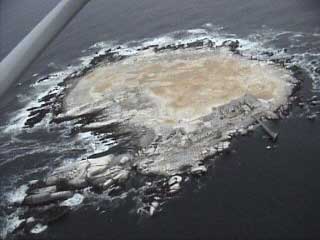
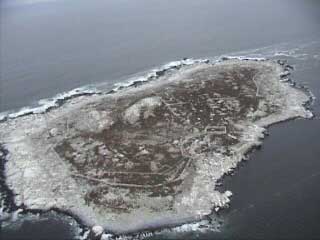
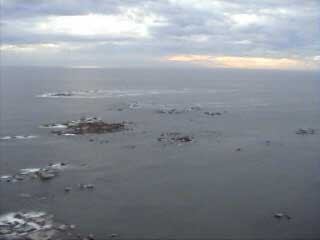
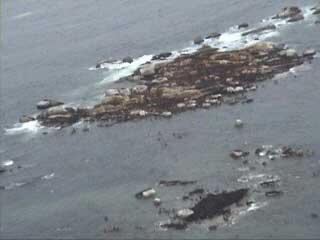
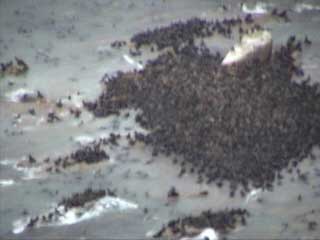
Storms, high winds and seas, will soon roll in at the start of Summer and Winter, where these rocks will become completely submerged, leaving seals with no-where to go.
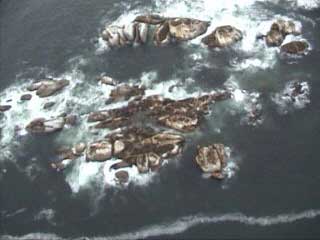
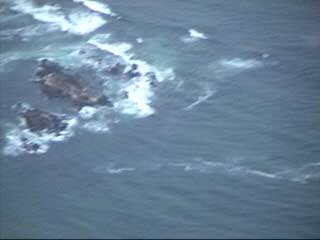
this entire seal population on 6 separate colonies would occupy less than 2 ha of the 273 ha island.
THE RESULT OF THIS GENOCIDE
Up to 10 metre waves pound these rocks.
Washing away and drowning over 90% of the new-born seal pups each year
AS THESE SEAL PUPS CAN'T SWIM FOR THEIR FIRST 6-WEEKS, THIS IS MASS GENOCIDE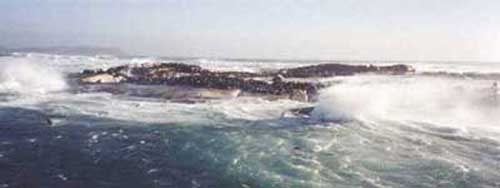
Genocide is defined by the Convention on the Prevention and Punishment of the Crime of Genocide
(CPPCG) article 2 as any of the following acts committed with intent to destroy, in whole or in part,
a national
ethnic
racial or religious
as such: "Killing members of the group; Causing serious bodily or mental harm to members of the group;
Deliberately inflicting on the group conditions of life calculated to bring about its physical destruction in whole or in part;
Imposing measures intended to prevent births within the group; and forcibly transferring children of the group to another group."
Killing members of a group - Shooting of seals attempting to re-colonise their endemic protected islands.
Causing serious bodily or mental harm to members of the group - Beating, clubbing, shooing seals especially during pupping and mating time in order to create mass disturbance, fleeing, abandonment of new-born, migration, induce premature birthing and disruption of mating behaviour.
Deliberately inflicting on the group conditions of life calculated to bring about its physical destruction in whole or in part - Denying seals the right to use the offshore islands they have been breeding upon for millions of years, confining them, to offshore rocks of less than 2ha, with heights of less than 4 metres, facing approaching ocean swells in excess of 6 metres, especially during pupping time.
Imposing measures intended to prevent births within the group - Overcrowding and unsuitable habitat.
Forcibly transferring children of the group to another group - Healthy pups to stranded starving pups, healthy pups to floating shark food pups, healthy pups to captive animals, healthy pups to drowned pups, healthy pups to abandoned pups. Healthy island pups to mainland seal harvestable pups.
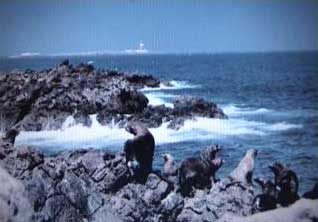
For the Seals
Francois Hugo - Seal Alert-SA
